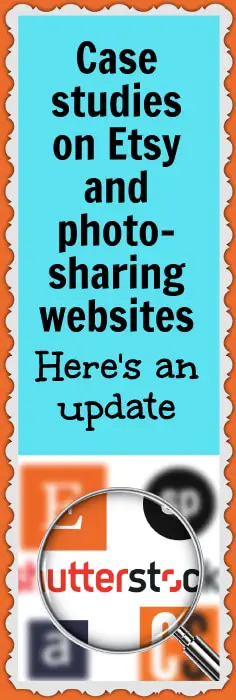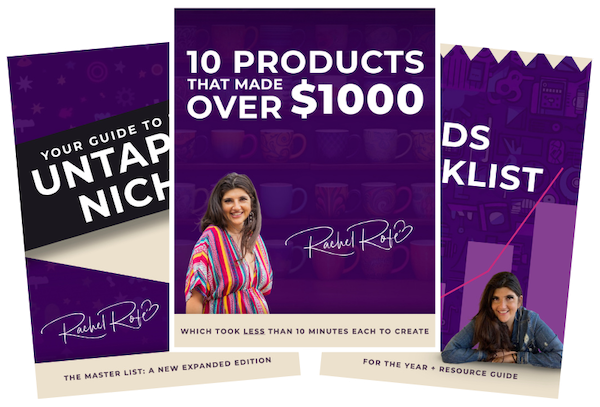In prior blog posts, I’ve shared all kinds of case studies with you.
Each time I do, we usually have a few weeks’ worth of results at the time, so people naturally ask for updates as time goes on.
It makes sense: you don’t want to waste your time or money investing in these strategies if they aren’t likely to pay off.
That’s why in today’s blog post, I decided to round up 3 past case studies and give you an update on their progress.
The three case studies we’ll be updating are:
- Etsy profit-sharing
- Add this easy upgrade option to your Etsy shop
- Make some passive income on photo-sharing websites
I chose these three because after the initial setup process, the income you earn is mostly passive, which is pretty fantastic.
(#1 does require a bit of maintenance each month, but not much.)
So let’s take a look at how these case studies are doing…
Case study #1: Profit-sharing with fellow Etsy sellers
I started this case study back in October 2017 and it’s something my assistant still checks in on regularly. You can read the details of the study here.
Basically, we contacted a bunch of Etsy sellers whose artwork we thought would look great on our mugs and other products.
Then, we offered to create a profit-sharing partnership with them where they give us permission to use their artwork and in exchange we give them 20% of each sale we make featuring their designs.
We ended up working with two Etsy sellers, who my assistant contacts monthly to let them know how many of their designs sold the previous month and to send them their 20% via PayPal.
To stay organized, she keeps a spreadsheet, noting the number of products sold each month, the amount they sold for, and the date each sale was made.
Here are my results to date:
I’ve made a total of $819.56 in sales, 20% of which ($163.91) has gone to the sellers, leaving me with a profit of $655.65.
These results aren’t super fantastic. But other than the initial back-and-forth, back when my assistant was first reaching out to sellers, this strategy takes very little time and doesn’t cost a thing.
Plus, if I were to have continued recruiting more Etsy sellers, I’m sure I could have made even more sales. All in all, I think this strategy is worth trying.
Case study #2: Adding an insurance upgrade to your Etsy shop
I first added the insurance upgrade option to my Etsy shops at the beginning of the 2018 holiday season. And after about a month, I’d made 8 sales.
Those results obviously aren’t super great. But at the time, I was hopeful that as holiday shopping picked up so too would the upgrade sales.
Here’s what happened since I wrote about this strategy on November 13th:
I made 11 new sales at the $2.50 price point for the insurance upgrade.
And while a total of 19 sales and $47.50 in profit is hardly a game-changer, adding an insurance upgrade option to your Etsy store takes less than 10 minutes and costs absolutely nothing.
So in this case, ever sale I make is pure profit.
NOTE: After I first wrote about this case study, a reader emailed me with a useful suggestion.
She brought up the point that it may be confusing to refer to this upgrade as “shipping insurance” since we already replace items if they’re damaged during shipping.
So because the insurance we offer covers damaged items up to 60 days after purchasing, she suggested calling the upgrade “Damaged Product Replacement Insurance” instead, which I think makes sense.
You are free to modify this technique however you want. You can change the name, change the timeframe, etc. (You can review all the details here.)
Just be upfront and clear about your policies and state exactly what the insurance covers / doesn’t cover (e.g. items damaged during shipment, lost / never received items, buyer accidentally damaging items, etc.).
Case study #3: Making passive income on photo-sharing websites
This case study is from May 2018. And with it, my assistant helped me upload a bunch of my Low Hanging System designs to photo-sharing websites.
I thought this would be a great way to earn extra money from things I’d already created.
There are lots of photo-sharing sites. But I chose these four:
- Shutterstock
- Adobe Stock
- Alamy
- Crestock
Let’s take a look at my results:
Shutterstock – $116.53, 294 downloads
Adobe Stock – $.71, 1 download
Alamy – $40, 2 sales
Crestock – $0, 0 downloads / sales
Getting results with this case study has been a numbers game. The more designs you upload, the more chances you have of making sales.
Since first reporting on the case study, I haven’t added any new designs to any of the photo-sharing sites. So the sales I made after the initial setup process have been earned 100% passively.
That said, $157.24 isn’t a huge amount of profit, but, again, it’s been earned mostly passively.
Plus, adding new designs takes 1-2 minutes max. So depending on the number of designs you have, this strategy, could, for sure, be worth your while.
Also, if you want to learn more about how you can translate your sales numbers into an hourly “wage,” check out the original post here.
I hope you find these case study updates useful! If you tried any of the strategies yourself, let me know how your results turned out by leaving a comment below.





